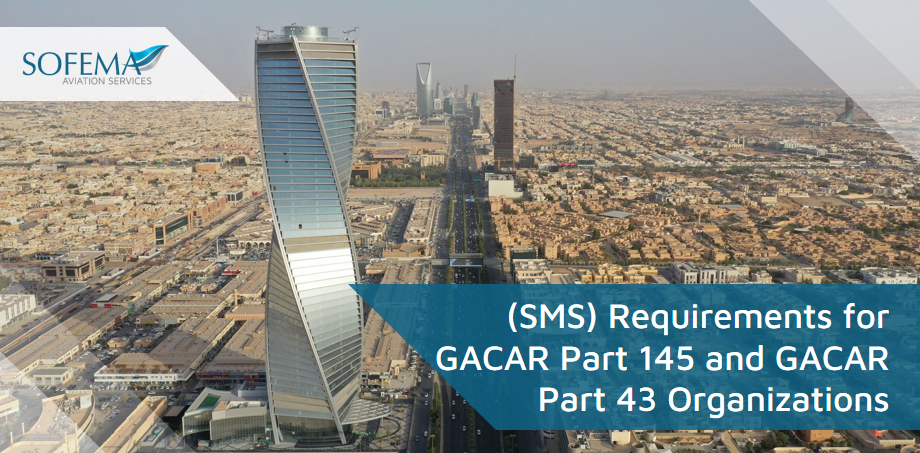Sofema Aviation Services (SAS) www.sassofia.com considers the requirements placed on Aviation Maintenance Organisations by the Kingdom of Saudi Arabia.
Introduction
In Compliance with the objectives of ICAO Annex 19, General Authority of Civil Aviation Regulations (GACAR) Part 145 (Repair Stations) and GACAR Part 43, Safety Management Systems (SMS) play an important role in ensuring the safety and operational efficiency of aviation organizations. The General Authority of Civil Aviation (GACA) mandates specific responsibilities and processes that organizations must implement to manage safety risks effectively.
General Requirements
Organizations operating under GACAR Parts 145 and 43 must establish, implement, and maintain an SMS appropriate to their size, complexity, and nature of operations. The SMS must enable the organization to continuously manage safety risks, comply with GACA regulations, and promote ongoing safety improvements.
Key Components of Safety Management System for GACAR 145 and 43 Organizations
The SMS must contain the following core elements:
- Safety Policy
- Commitment to Safety: The organization must develop and maintain a safety policy outlining its commitment to maintaining a high level of safety, supported by clear safety objectives.
- Allocation of Resources: Ensure the provision of adequate resources to implement and maintain the SMS.
- Emergency Response Planning: Develop an emergency response plan to guide the organization through the transition from normal to emergency operations and back to normal.
Best Practices:
- Ensure the safety policy is signed by the accountable executive and reviewed regularly to keep it relevant.
- Foster a safety culture that encourages employees to report hazards without fear of blame or punitive action.
- Continuously communicate the safety policy and emergency response plan to all personnel.
- Safety Accountability and Authority
- Defined Responsibilities: Clearly define accountability for safety at all levels of the organization, from top management to operational personnel.
- Management is responsible for implementing and overseeing the SMS in their area of responsibility.
- Employees are responsible for reporting hazards and complying with safety procedures.
- Designation of Accountable Executive: Appoint an accountable executive who has the authority over operational and safety matters, including the allocation of financial and human resources to support the SMS.
Best Practices:
- Ensure that safety responsibilities are communicated and understood throughout the organization.
- Provide training for management and employees to understand their roles in maintaining the SMS.
- Appoint a qualified and competent safety manager to oversee SMS processes and provide regular reports to the accountable executive.
- Hazard Identification and Safety Risk Management
- Hazard Identification: Develop processes to proactively and reactively identify hazards in maintenance and repair operations.
- Risk Assessment: Conduct systematic risk assessments to determine the likelihood and severity of potential hazards. Implement appropriate risk controls to manage unacceptable safety risks.
Best Practices:
- Use risk analysis tools to identify and evaluate risks.
- Encourage employees to report hazards through a confidential reporting system.
- Continuously review and update risk controls based on operational experience and data.
- Safety Assurance
Monitoring and Auditing: Establish processes to monitor safety performance and conduct regular audits of maintenance operations and safety procedures.
- Continuous Improvement: Implement corrective actions where safety controls are found to be ineffective and regularly review the SMS to identify opportunities for improvement.
Best Practices:
- Develop key safety performance indicators (SPIs) to measure and track safety performance over time.
- Conduct periodic internal and external audits to verify compliance with GACA regulations and organizational policies.
- Create a corrective action program to address deficiencies identified during audits or safety reviews.
- Safety Promotion
- Training and Competency: Provide safety training to all personnel to ensure they are aware of SMS processes and their responsibilities within the system.
- Safety Communication: Develop methods to communicate safety-critical information, explain changes in safety procedures, and promote the SMS across the organization.
Best Practices:
- Offer refresher SMS training on a regular basis to keep staff updated on the latest safety standards and practices.
- Utilize multiple channels (e.g., newsletters, safety bulletins, team meetings) to promote safety awareness.
- Encourage open discussions on safety topics and actively involve employees in safety improvements.
- SMS Documentation and Recordkeeping
Documentation: Maintain a comprehensive record of all SMS-related activities, including safety policies, risk assessments, audits, and corrective actions.
- Record Retention: Ensure that SMS records are kept for a minimum of five years and are readily accessible for audits and safety reviews.
Best Practices:
- Use digital tools to streamline the documentation and recordkeeping process.
- Ensure that all changes to safety policies, procedures, and controls are documented and communicated to relevant personnel.
Specific Obligations for GACAR 145 Organizations
GACAR Part 145 organizations (Repair Stations) must ensure their SMS addresses the unique risks associated with aircraft maintenance, repair, and overhaul operations. Key obligations include:
- Compliance with Repair Standards: Ensure that all maintenance activities comply with GACAR standards and manufacturer specifications to prevent safety incidents.
- Safety Audits: Conduct regular safety audits and inspections of maintenance activities, tools, and facilities.
- Flight Safety Documents System (FSDS): Maintain an organized FSDS that compiles necessary documentation for both flight and ground operations. This system must ensure the timely availability of critical safety information.
Best Practices:
- Implement a safety auditing schedule that ensures compliance with all repair standards.
- Ensure that maintenance personnel receive regular training on SMS principles, especially in areas of hazard identification and risk management.
Specific Obligations for GACAR 43 Organizations
Organizations operating under GACAR Part 43 (General Maintenance) have specific SMS obligations related to general aviation maintenance. Key obligations include:
- Inspection and Testing: All maintenance, preventive maintenance, and alterations must be properly documented, inspected, and tested to meet airworthiness standards.
- Hazard Identification: Focus on identifying hazards specific to general aviation maintenance, such as errors in component replacement, missed inspections, or incomplete maintenance records.
Best Practices:
By incorporating proactive safety practices, enhancing employee involvement, utilizing technology for monitoring and reporting, and committing to continuous improvement, GACAR 145 and 43 organizations can significantly improve safety outcomes.
This will lead to not only regulatory compliance but also a robust and resilient safety culture.
Consider the following:
- Strengthen the use of confidential, non-punitive reporting systems where all employees can report hazards, errors, or near misses.
- Encourage early identification of small issues before they escalate into larger risks.
- Use formal risk assessment to evaluate the risks associated with maintenance tasks.
- Regularly review and update risk assessments to account for changes in equipment, processes, or regulations.
- Regularly conduct both internal and external safety audits, focusing not only on regulatory compliance but also on operational risks.
- Audits should assess the effectiveness of SMS, equipment reliability, training adequacy, and procedural adherence.
- Implement continuous safety monitoring systems. These indicators help detect early signs of safety performance decline.
- Use software tools for real-time safety performance monitoring, capturing data on key performance indicators (KPIs).
- Strengthen the MOC process to ensure that changes to equipment, procedures, or staffing levels are assessed for safety impacts.
- This should involve risk assessments and safety validation tests before changes are fully implemented.
- Management should actively participate in safety reviews, audits, and meetings.
- Their engagement reinforces the importance of safety and shows a top-down commitment to the SMS.
- Appoint safety champions or liaisons within various maintenance teams.
- These individuals act as a bridge between management and staff, ensuring that safety issues are addressed promptly and fostering peer-to-peer communication on safety matters.
- Ensure safety communication is a two-way process where staff feel comfortable raising issues without fear of reprisal.
- Implement mechanisms for employees to provide feedback on the SMS itself, such as surveys or suggestion boxes, and ensure that feedback is considered for system improvements.
- Ensure that all personnel, from senior management to frontline maintenance staff, receive tailored SMS training that is relevant to their specific roles and responsibilities.
- Include training on hazard identification, risk management, and proper reporting protocols.
Optimize Your GACAR 145 and 43 Organizational SMS
- Risk-Based Approach: Incorporate risk management into everyday operations, ensuring risks are continuously identified, assessed, and mitigated.
- Safety Culture: Promote a proactive safety culture by encouraging the reporting of hazards and non-punitive reporting systems.
- Data-Driven Decision-Making: Use data from audits, incident reports, and safety performance metrics to inform decision-making and guide safety improvements.
Compliance and Continuous Improvement
Both GACAR 145 and 43 organizations must comply with GACA regulations and continually strive to improve their SMS by:
- Regular Reviews: Conduct regular reviews of SMS processes to ensure they remain relevant and effective.
- Adaptation: Adjust the SMS to reflect changes in regulatory requirements, organizational structure, or operational complexity.
- Employee Engagement: Involve all personnel in safety discussions, empowering them to contribute to safety improvements.
Next Steps
Follow this link to our Library to find & download related documents for Free.
Sofema Aviation Services www.sassofia.com provides regulatory training compliant with GACAR Parts 43 and 145. Please see the following link or email team@sassofia.com.
Tags:
Safety Culture, GACA Safety, Maintenance Safety, GACAR Compliance, Aviation Compliance, aviation standards, ICAO Annex 19, Aviation Regulations, Part 43, Aircraft Maintenance, Sofema Aviation Services, sms implementation, Safety Management systems, Risk Management, Regulatory training, Part 145, Aviation Training, aviation safety





